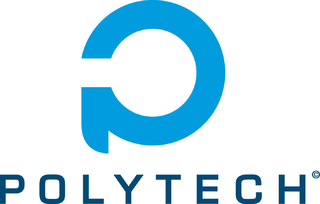In computer engineering, a hardware description language (HDL) is a specialized computer language used to describe the structure and behavior of electronic circuits, most commonly to design ASICs and program FPGAs.

École Centrale de Nantes, or Centrale Nantes, is a grande école - a French engineering school - established in 1919 under the name of Institut Polytechnique de l'Ouest. It provides Bachelor, Graduate, Master, and PhD Programmes based on the latest scientific and technological developments and the best management practices.

Mentor Graphics Corporation was a US-based electronic design automation (EDA) multinational corporation for electrical engineering and electronics, headquartered in Wilsonville, Oregon. Founded in 1981, the company distributed products that assist in electronic design automation, simulation tools for analog mixed-signal design, VPN solutions, and fluid dynamics and heat transfer tools. The company leveraged Apollo Computer workstations to differentiate itself within the computer-aided engineering (CAE) market with its software and hardware.
A platform-independent model (PIM) in software engineering is a model of a software system or business system that is independent of the specific technological platform used to implement it.

The École nationale supérieure d'informatique et de mathématiques appliquées, or Ensimag, is a prestigious French Grande École located in Grenoble, France. Ensimag is part of the Institut polytechnique de Grenoble. The school is one of the top French engineering institutions and specializes in computer science, applied mathematics and telecommunications.
Electronic system level (ESL) design and verification is an electronic design methodology, focused on higher abstraction level concerns. The term Electronic System Level or ESL Design was first defined by Gartner Dataquest, an EDA-industry-analysis firm, on February 1, 2001. It is defined in ESL Design and Verification as: "the utilization of appropriate abstractions in order to increase comprehension about a system, and to enhance the probability of a successful implementation of functionality in a cost-effective manner."

The systems modeling language (SysML) is a general-purpose modeling language for systems engineering applications. It supports the specification, analysis, design, verification and validation of a broad range of systems and systems-of-systems.
AWR Corporation is an electronic design automation (EDA) software company, formerly known as Applied Wave Research, and then acquired by National Instruments
Trillium Digital Systems, Inc. developed and licensed standards-based communications source code software to telecommunications equipment manufacturers for the wireless, broadband, Internet and telephone network infrastructure. Trillium was an early company to license source code. The Trillium Digital Systems business entity no longer exists, but the Trillium communications software is still developed and licensed. Trillium software is used in the network infrastructure as well as associated service platforms, clients and devices.

The Polytech Group is a French network of 15 public graduate schools of engineering within France's leading technological universities:
Catapult C Synthesis, a commercial electronic design automation product of Mentor Graphics, is a high-level synthesis tool, sometimes called algorithmic synthesis or ESL synthesis. Catapult C takes ANSI C/C++ and SystemC inputs and generates register transfer level (RTL) code targeted to FPGAs and ASICs.
JEDA Technologies, Inc. (“JEDA”) is a provider of software products in the front-end of electronic design automation (EDA) industry, specifically in electronic system-level (ESL) verification automation. JEDA products are applied to design models written in C, C++, SystemC for quality measurement, checking and improvement. The company is headquartered in Santa Clara, California with R&D offices in China.
Glenford Myers is an American computer scientist, entrepreneur, and author. He founded two successful high-tech companies, authored eight textbooks in the computer sciences, and made important contributions in microprocessor architecture. He holds a number of patents, including the original patent on "register scoreboarding" in microprocessor chips. He has a BS in electrical engineering from Clarkson University, an MS in computer science from Syracuse University, and a PhD in computer science from the Polytechnic Institute of New York University.

Bordeaux Institute of Technology- ENSEIRB-MATMECA School of Engineering is a French Engineering Grande École located in Bordeaux and specialized in Electrical Engineering, Electronics, Computer Science, Telecommunications, Mechanical Engineering and Mathematics.
OVPsim is a multiprocessor platform emulator used to run unchanged production binaries of the target hardware. It has public APIs allowing users to create their own processor, peripheral and platform models. Various models are available as open source. OVPsim is a key component of the Open Virtual Platforms initiative (OVP), an organization created to promote the use of open virtual platforms for embedded software development. OVPsim requires OVP registration to download.

Sparx Systems Enterprise Architect is a visual modeling and design tool based on the OMG UML. The platform supports: the design and construction of software systems; modeling business processes; and modeling industry based domains. It is used by businesses and organizations to not only model the architecture of their systems, but to process the implementation of these models across the full application development life-cycle.
Model-based systems engineering (MBSE), according to the International Council on Systems Engineering (INCOSE), is the formalized application of modeling to support system requirements, design, analysis, verification and validation activities beginning in the conceptual design phase and continuing throughout development and later life cycle phases. MBSE is a technical approach to systems engineering that focuses on creating and exploiting domain models as the primary means of information exchange, rather than on document-based information exchange. MBSE technical approaches are commonly applied to a wide range of industries with complex systems, such as aerospace, defense, rail, automotive, manufacturing, etc.

VisualSim Architect is an electronic system-level software for modeling and simulation of electronic systems, embedded software and semiconductors. VisualSim Architect is a commercial version of the Ptolemy II research project at University of California Berkeley. The product was first released in 2003. VisualSim is a graphical tool that can be used for performance trade-off analyses using such metrics as bandwidth utilization, application response time and buffer requirements. It can be used for architectural analysis of algorithms, components, software instructions and hardware/ software partitioning.








